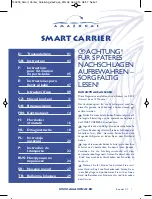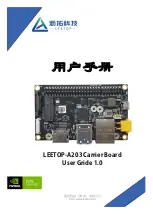
7.
5.
Pull the webbing strap on the
Back/Chest Strap
to
tighten. The
Shoulder Straps
should be wide and the
Back/Chest Strap
should be straight across your back.
* NOTE: The height of the
Back/Chest Strap
can be adjusted
by sliding the
Back/Chest Strap
to the desired height. The
strap should lay in a comfortable position on your upper back.
6.
Fasten the
Waist Belt & Buckle
around your waist and
pull the webbing to tighten.
*NOTE: People with longer torsos may find a higher belt
position more comfortable (closer to the navel); shorter people
may wish to wear the belt more on the hips.
* IMPORTANT! ALWAYS ensure that the
Waist Belt
fits
securely against your body at all times without creating a gap.
7.
Fasten the
Side Closure Buckle
on one side. This step
will create a
Leg Opening
on the closed side.
8.
With the carrier open on one side and the baby facing
you, carefully slide the baby into the carrier by fitting his/
her leg through the
Leg Opening
on the closed side of
the carrier.
*IMPORTANT! Keep one hand on the baby until all buckles
and straps are properly fastened.
*Make sure your baby’s leg goes through the
Leg Opening
on
the closed side of the carrier.
CORRECT
INCORRECT
8.
9.
While supporting the baby with one hand, fasten the
other
Side Closure Buckle
.
10.
Support the baby’s head by attaching the two
Head
Support Buckles
above each arm. Adjust the size of
the
Head Support
by pulling both of the
Head Support
Straps
.
*IMPORTANT! Always make sure there is enough room around your baby’s
face to provide a clear source of air.
11.
Attach the
Leg Strap
to the
Leg Strap Button
on BOTH
SIDES of the carrier.
*IMPORTANT! For babies between 8-11 lbs (3.6-5 kgs), the
Leg Straps
must be attached to make the leg opening smaller and to avoid a
potential falling hazard.*NOTE: For babies over 11 lbs (5 kg), this step is
unnecessary.
12.
To adjust how high the baby rides on your chest, lift the
baby slightly and pull the
Shoulder Strap Adjuster
, first
on one strap, then on the other. The
Shoulder Strap
Adjusters
should be equal lengths after adjusting.
When the baby is properly positioned you should be
able to tilt your head forward and kiss the top of your
baby’s head.
*NOTE: Wearing the carrier closer to your body and higher up on your chest
will minimize stress to your back and shoulders from prolonged use.
*IMPORTANT: Always make sure baby’s face, nose, and mouth are not
obstructed. Check your baby’s position regularly. Your baby should be
centered in the carrier in a seated position with arms and legs extended and
not constricted by the carrier. It is extremely important to avoid any slouching
in baby’s position. A slouching position can restrict baby’s airways. Baby’s
head should be upright or resting on your chest with the face, nose, and
mouth positioned to the left or right. Baby’s chin should never rest on baby’s
chest. This can result in closing or partially closing baby’s airway.



















